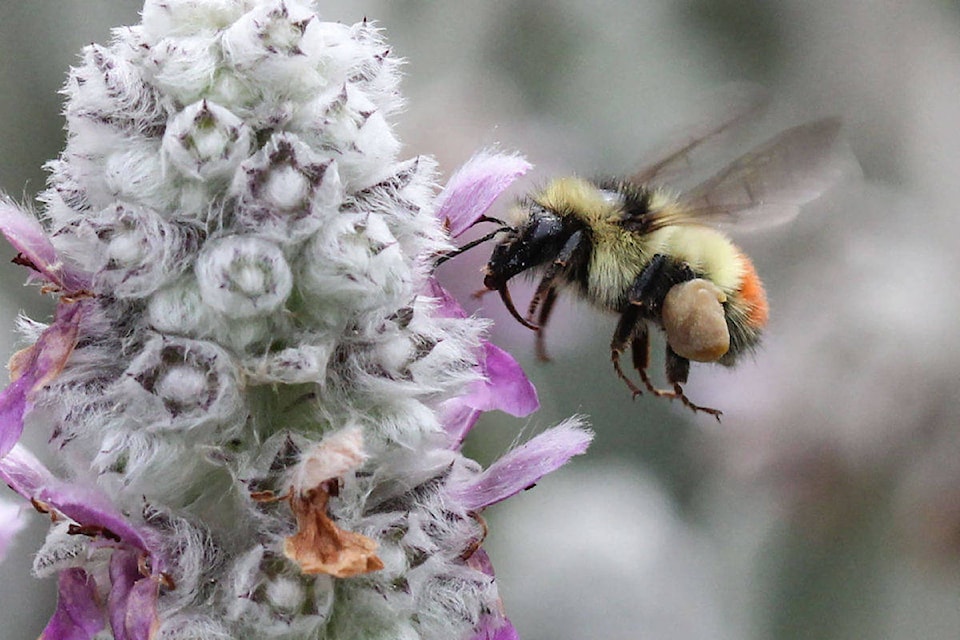A bee symposium to be held Kelowna next week is generating buzz about what can be done to help the local bee population.
In Vernon, a beekeeper was concerned for his bees after a large number of them died. At the time, he suspected it was a virus.
READ MORE: Vernon beekeeper concerned after spike of deaths in bee population
Keynote speaker Victoria Wojcik, research director the Pollinator Partnership, said it��ѻ��ý�s difficult to determine the actual cause of bee deaths, but pesticides play both a short long-term role.
In her presentation, Wojcik will be giving an overview of the program Pollinator Partnership does Canada-wide, which promotes the use of native plants and gives a guide on which plants are bee friendly in the country��ѻ��ý�s many regions.
��ѻ��ý�The number one thing you can do to help bees is provide floral habitats,��ѻ��ý� she said. ��ѻ��ý�It sounds pretty simple but when you actually get around to providing that habitat, other questions come up like what do I plant, where do I plant it?��ѻ��ý�
It��ѻ��ý�s difficult to track how the Okanagan��ѻ��ý�s bees are doing, because of the diversity of plant and bee systems, Wojcik said.
Loss of habitat due to agricultural farm and urban as well as pesticide use contribute to declining bee populations.
Nicotine-based pesticides are showing in high levels in aquatic systems, and have been in use for the past 15 years, Wojcik said.
��ѻ��ý�What��ѻ��ý�s problematic about the neo-nicotine pesticides is that the impact they have on bees, in terms of native bee health and honey bee health, it��ѻ��ý�s very rarely a direct mortality impact,��ѻ��ý� she said. ��ѻ��ý�The incidents of bee deaths because of direct pesticide are pretty low across Canada.��ѻ��ý�
��ѻ��ý�What��ѻ��ý�s more common, which is much more difficult to assess and manage and is actually much more scary, in terms of overall be health, is that you have interactions with the hives that lead to sublethal effects, whether it impacts the nutrition of the hive, where is affects their ability to access the nutrients in their food.��ѻ��ý�
In August, the federal government agreed to being phasing out outdoor use of three nicotine-based pesticides starting in 2021.
READ MORE: Pesticides linked to bee deaths will be phased out in Canada, sources say
��ѻ��ý�With regulation coming into place with restrictions and phase out of these particular products, we should see an improvement in bee health because they won��ѻ��ý�t be constantly subject to these pesticides in the environment,��ѻ��ý� Wojcik said.
Wojcik said B.C.��ѻ��ý�s bees are doing as well, or slightly less than, the rest of Canadian bees.
With honey bees, there was a recorded 30 per cent loss within the last two years, but Wojcik said it��ѻ��ý�s difficult to track regional numbers, or get official data on every bee species in B.C.
Nancy Holmes is a professor at UBCO and representative of Border Free Bees, which has ongoing projects in the Lower Mainland, US and Mexico.
��ѻ��ý�I hear lots of reports of honey bee die offs and I just don��ѻ��ý�t know how much follow up on the reasons, very often its often a perfect storm of problems.��ѻ��ý�
She said UBCO is hosting the symposium because of the interest people have in the community.
Holmes is hoping to get a grant and do research with a biologist at UBCO to do an assessment on the local bee population. As a hotspot for bee populations, the Okanagan has more than 360 different species of bee, she said.
Most of the bee population lives in the ground, it may be green, it may be the size of a fruit fly, but they��ѻ��ý�re all master pollinators, she said.
The public events begin with a free talk by Mace Vaughan of the renowned insect conservation organization, The Xerces Society. Vaughan, who supervises the largest pollinator conservation team in the US, will give a talk called Bring Back the Pollinators: What You Need to Know to Save Native Bees Oct. 12 at the Laurel Packinghouse, at 7 p.m.
Talks and workshops continue throughout the weekend with talks, workshops and ends Sunday with a plant rescue field trip.
More information can be found at . For a list of Okanagan bee friendly plants, resources can also be found through the Border Free Bees website.
edit@kelownacapnews.com
Like us on and follow us on .



